
Global demand for U.S. cheese is accelerating, driven by expanding international markets and evolving consumer tastes. At the same time, trade negotiations and tariff policies remain key factors shaping the future of dairy exports.
William Loux, senior vice president of global economic affairs for the National Milk Producers Federation (NMPF) and the U.S. Dairy Export Council (USDEC), says the dairy industry is finally turning a corner. After years of market volatility, he sees growing stability on the farm and rising international demand, especially for cheese and dairy proteins, as encouraging signs of progress.
“I’m pretty optimistic about [the state of the dairy industry],” Loux says. “I’m not always the optimistic person as the numbers guy, I kind of give the ‘real’ talk, but in general, profitability on the farm looks good, and we’ve got a situation where demand, especially internationally, is starting to recover.”
He shared these insights in a recent appearance on “AgriTalk” where he discussed the current state of U.S. dairy and what is driving renewed optimism across export markets.
Cheese is Leading the Charge
While domestic cheese sales remain soft, global cheese demand is accelerating rapidly. Much of that growth is coming from international restaurant menus that are incorporating cheese in new and creative ways.
“I think a lot of that goes to work that the export council has done,” Loux says. “We have a whole cheese marketing program as part of that group internationally. And you can look at [these restaurants] adapting their menus to local tastes, but I think the big success that we’ve also had, for example in Korea, is looking at traditional restaurants, like Korean barbecue, that now has cheese dips as offerings at many of those restaurants. So it’s not just the U.S. coming in and saying, ‘here’s our [restaurant] companies, how do you adapt it.’ It’s the local companies that are also seeing opportunities [to add dairy].”
Loux says this growth in demand is broad-based and happening faster than before the pandemic.
“Over the last 12 months, 12 out of the top 13 global cheese markets have all increased their demand, and that is unusual,” he says. “We are growing at twice the speed we were pre-COVID. The U.S. is the one benefiting here first and foremost, we are growing faster than any other exporter in the world, but we aren’t the only ones. New Zealand and Australia both had record years, Europe is growing, too, so the competition isn’t evading. But at the same time, this demand is a bright spot for global dairy prices. We are seeing good cheese demand [internationally], which we desperately need right now, and that is a positive signal for dairy.”
Beyond cheese, other dairy products are gaining traction in international markets as well. Whey proteins and milk proteins, in particular, are seeing increased demand across Asia. Still, Loux acknowledges the market is mixed.
“When you look outside of the cheese market at everything else, non-fat is a little soft; dry whey — we have some trade issues with China,” he says. “But I look at this market and say, hey, we are finally starting to turn the corner on some of this global demand. There are plenty of risks ahead, but I look at the state of the industry and say that we’ve weathered through some pretty tough times, especially in 2023 and into 2024, and now I think with the capacity, there is a great opportunity for U.S. dairy moving forward.”
Exports as a Balancing Act
Exports play a crucial role in stabilizing and expanding the U.S. dairy industry. Loux points to two key advantages that exports provide.
“First off, it brings balance to your milk check,” he says. “Fundamentally, even as we see higher butterfat in our components, we’re not making pure cream out of the cow. So, we have to find opportunities to grow our skimmed side, and that’s our proteins and caseins. And internationally, folks are demanding more of that and are asking for it — 75% of our nonfat dry milk and 50% of our dry whey goes overseas. And we fundamentally need that to keep our prices balanced.”
Loux also sees exports as a vital engine for long-term industry growth.
“Over the last number of years, the U.S. has increased its cheese exports more than we have increased our domestic cheese consumption,” he adds. “Mexico in particular has been an incredibly strong cheese market for us over the last number of years, but even as they’ve slowed down, because we’ve emphasized being in multiple markets, particularly in Asia and elsewhere, U.S. cheese exports are still on pace for another record year.”
Much of this momentum is tied to protein’s growing popularity worldwide. Once limited to sports nutrition and infant formula, dairy proteins are now appearing in everyday products such as cookies and soups in Japan, signaling a broader shift in consumer demand across global markets.
Expanding Access into the UK
Following the recent announcement of a trade agreement between the U.S. and the United Kingdom, there is cautious hope for increased dairy exports to the region. But Loux urges a measured outlook.
“Right now, not a whole lot has actually been completed,” he says. “When we look at reading the fine print, it really looks like they’ve only agreed to keep talking, and I think they’ve avoided some of the tariffs within the reciprocal agreement. So, we aren’t seeing much access for dairy yet.”
Despite the lack of movement, Loux points out the UK does present significant potential for U.S. dairy exports, as it is the largest cheese-importing country in the world. However, roughly 90% of those imports come from European suppliers.
“As we look at opportunities, the UK buys, imports and eats a lot of cheese,” Loux states. “But they also need proteins, and that’s what the UK wants. And the U.S. is the fastest growing exporter of that product.”
Loux says that if a formal agreement can be reached, the U.S. dairy industry stands to benefit. Still, it all depends on the final details.
“We need to wait to see the fine print and figure out what this deal actually looks like,” he adds.
Tariffs: Short-Term Pain or Long-Term Gain?
When it comes to tariffs, Loux sees them as a necessary part of the conversation, but not a long-term solution.
“I’ll be honest with you, I’m a free trader,” he says. “I’m a fan of exports, but I’m also a fan of consumer choice. At least as it comes to within the U.S. and everything else, I’m fine with Kerrygold or whatever being on the shelves. But I also want the U.S. [dairy] to have access to Irish shelves, right?”
Lack of reciprocal trade, particularly with Europe, remains a major concern for Loux. In some cases, such as retaliatory tariffs on European butter and cheese, there might be justification. But Loux warns that blanket tariffs can have unintended consequences on consumer behavior and the broader economy.
“Ten percent tariffs certainly do have an inflationary aspect to them, and I think that is the risk,” he says. “I’m not going to get too much into the macro side, but if you see U.S. consumers stop going out to eat as much because they’re just in a worse financial position, that’s a risk for dairy markets.”
Rather than more tariffs, Loux advocates for trade agreements that promote open access and growth.
“What we’ve always advocated for in international markets is twofold,” he states. “When we go and have agreements with places like Korea or Japan or Central America, our argument is usually that lower tariffs actually can grow demand overall and benefit both the local industry as well as U.S. dairy exports. And as we look at this internationally, that’s where I’d like to see lower tariffs, not more tariffs. I want more demand and consumption for everybody.”
For Loux, the goal is simple.
“From an economic perspective, I kind of want more demand and more consumption for everybody,” he says.
Trade to India Remains Out of Reach
Recently, India has dominated the conversation when it comes to global trade. However, Loux believes U.S. dairy trade with the country will likely remain out of reach.
“It comes up in every trade conversation, and I think it is probably the most asked question, or most asked country I get asked about,” Loux says. “It’s the biggest dairy consumer in the world. It would make sense as an opportunity for U.S. dairy.”
But despite the sheer scale of potential demand, the barriers remain firmly in place.
“Between the non-tariff barriers and the political sensitivity around dairy, I have no expectations that we’re getting any sort of real access into India,” he explains.
This isn’t a new struggle.
“We have tried for 20 to 30 odd years to get access into India,” Loux adds. “The Kiwis have tried for 20 to 30 years to get access into India. Canadians, too. So far, no one has.”
He remains skeptical about any breakthroughs on the horizon.
U.S. Dairy Remains in a Strong Position
While dairy has certainly seen its fair share of challenges throughout 2025, Loux is encouraged by where U.S. dairy stands today. After years of volatility, he sees signs of recovery, especially as global demand for cheese and proteins gains momentum.
While hurdles like tariffs and trade barriers remain, Loux believes U.S. dairy is well-positioned for growth. He points to recent export success, expanding opportunities in markets like the UK, and the industry’s ability to adapt to shifting global demand.
Challenges with countries like India persist, but Loux is confident that with continued focus and smart trade strategy, U.S. dairy can keep gaining ground worldwide.
You can now read the most important #news on #eDairyNews #Whatsapp channels!!!
🇺🇸 eDairy News INGLÊS: https://whatsapp.com/channel/0029VaKsjzGDTkJyIN6hcP1K






















